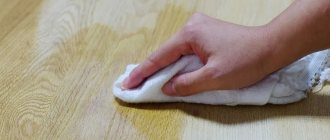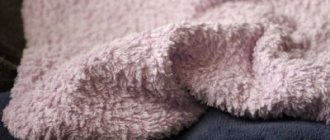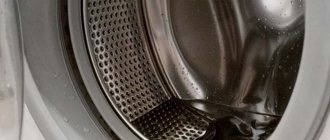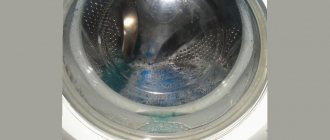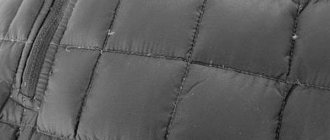Often, after washing a down jacket, stains and streaks form on its surface.
There may be several reasons for their appearance - improper rinsing, inappropriate detergent, insufficient spinning or failure to follow drying rules.
The choice of method to eliminate the problem depends on the cause of its occurrence.
You can determine the cause by carefully examining such spots: what color they are, where they appeared, and what size they are. So, why did stains appear after washing a down jacket and how to remove them?
Washing rules
In order not to think about how to wash yellow stains on a down jacket later, you must adhere to the following rules:
- Do not use regular washing powders when washing, because the density of fluff and the texture of the fabric make it impossible to completely wash out the powder detergent. Choose a high-quality liquid concentrate or gel. If you decide to use traditional powder, then its amount must be reduced.
- Turn clothes inside out before washing.
- Load three tennis balls into the washing machine along with the down jacket. They will prevent fluff from clumping and increase the efficiency of the rinsing process. Yellow stubborn stains form due to the accumulation of filler in one place. This leads to the release of a small amount of fat.
- The spin should be set at maximum speed so that water does not drip from the product.
- Wash white down jackets by hand. Apply detergent sparingly and wash it off with a sponge.
The “culprits” for the appearance of stains on clothes
Repairers of washing units note that there are more than a dozen reasons why a machine can dirty things. They are all divided into:
- serious - associated with malfunctions in the machine itself;
- of a simple nature - caused by violations of the rules for operating household appliances.
Simple factors for the appearance of pollution
- Drum overload. You can put the maximum amount of laundry in the washing machine allowed by the manufacturer. Otherwise, the washing powder will get into the folds of clothes and be difficult to wash out of them. This will lead to the appearance of light orange or red spots, which are unlikely to get rid of without additional rinsing.
- Incorrect amount of powder.
- Weak water pressure. This leads to the fact that the powder from the compartment is poorly washed out at the beginning of the cycle and gets into the process already during rinsing.
- Leaving laundry in the drum for a long time after the end of the cycle can lead to the appearance of a musty smell and light stains on things.
- Kalgon. Store-bought descaler can settle on laundry (especially white fabrics) and cause yellow stains. Avoid such chemicals and use, for example, citric acid instead.
- Bleach. If you violate the dosage of chlorine-containing products, you will definitely see white spots on your laundry when you take things out of the drum.
Eliminating the above reasons that lead to flaws is as easy as shelling pears. Enough:
- increase the water pressure to better rinse clothes from detergent;
- put the powder not in a special compartment, but directly to the laundry, in a drum container;
- buy and use liquid detergents that do not leave dark, light or any other stains on clothes.
Other factors causing stains
Have you checked everything, but haven’t found the reasons described above why things get dirty due to the fault of the machine? Most likely, we are talking about problems of a more serious nature:
- Seal failure. The appearance of greasy stains on the fabric is a clear sign of its breakdown. When the unit operates, the oil seal lubricant gets onto the laundry and stains it. The malfunction can be eliminated by replacing the part.
- Bearing failure. Recognizing the problem is quite simple: the machine begins to make a lot of noise during the spin cycle, and gray or blue smudges remain on the products. To avoid trouble, you should change the seals on time, and also wash them less often at a temperature of 90 degrees.
- Dirt on and under the rubber cuff. When starting the machine, it can get into the drum and stain the laundry. Brush the cuff regularly and wipe dry after each cycle.
- Fungus on the drum or pipes. The characteristic musty odor of mold and mold will help identify the problem. The main reason for the appearance of fungus is the tightly closed machine door at the end of the wash. Do not close the hatch immediately after turning it off and let it dry. Has the fungus already appeared? An idle cycle with the addition of soda or a small amount of citric acid will help get rid of it.
- Dirty water. Have you taken things out of the drum and still have rusty stains on them? Most likely, the problem is in water with a high iron content. The latter penetrates into the fibers and, oxidizing in the air when the laundry dries, turns into red stains. A special filter for the machine will help you cope with the problem. You can also try draining the tap water for 10-15 minutes before starting the unit.
- Drain hose or filter clogged. Foreign objects (accessories from things, small particles) often get into them, which lead to negative consequences. By cleaning the filter and hose, you can quickly solve your stain problem.
Drying
How to dry a thing so that you don’t have to think about how to remove yellow stains from a down jacket? In general, drying winter clothes turns out to be much more difficult than washing them.
Basic drying rules:
- Dry your down jacket on a terry towel spread out on a flat surface in a horizontal position or on hangers in a vertical position.
- During drying, it is necessary to shake the product from time to time and break up any lumps that have formed.
- To speed up the drying process, you can use a heat fan.
- It is best to dry clothes in the fresh air.
Vertical cleaning of a down jacket by hand.
Try to wash a light down jacket in the same way (as any other), no more than 2-3 times a year. Over time, under the influence of detergents, the fabric begins to darken. To avoid frequent washing in the washing machine, you will have to frequently wash your down jacket in local, especially dirty places.
Gentle vertical “washing” is done like this:
- Hang a down jacket over the bathtub.
- Make a soap solution of a special liquid detergent for down products (or a solution for winter sportswear).
- Whip up a thick foam and gently wipe the collar, sleeves, pockets, sides of the jacket and hem with a foam sponge.
- In heavily contaminated areas, you can leave the foam for 20-30 minutes so that it works better and has time to soften the dirt.
- Then gently rub all dirty places on the white down jacket with the soft side of the sponge and rinse gently.
⚠️ Attention! The thing is light, so the sponge must be NEW . It is advisable to check it for “shedding”. Lather a wet sponge and wring it into a white cotton cloth. If there are no traces left, you can use it for a light down jacket.
Try to ensure that the liquid does not get inside the down jacket; it remains all outside.
How to get rid of yellow stains?
If you still have yellow stains on your down jacket, then you need to try to get rid of them. Unfortunately, there is no universal remedy that would help remove such stains, but there are some subtleties and tricks on how to remove them or make them less noticeable.
Important! The simplest option is to re-wash and rinse several times. This must be done using special products for down jackets or capricious items.
Let's look at the most popular means by which you can get rid of divorces.
Peroxide:
- Take a white, clean and natural fabric.
- Soak it in hydrogen peroxide.
- Go through all the places on the jacket where stains appeared.
- Saturate the cloth with peroxide, wiping away any yellow stains.
Important! Please note that bright colored and dark fabrics cannot be treated with this product.
Salt and vinegar
On winter clothes, along with yellow stains, there may also be stains of other origins that the detergent did not cope with. To remove them along with stains:
- Mix half a spoon of salt and a spoon of 9% food vinegar.
- Dilute this mixture with half a liter of running water.
- Apply to a clean cloth and wipe problem areas.
Important! Make movements directed towards the dirt so that the stains do not spread over the entire surface of the product.
Important information
In order for the process of getting rid of yellow spots to be successful, you must adhere to the following recommendations:
- You should not rub your sneakers too vigorously, trying to remove yellowness from them. The fabric may not withstand intense exposure and may tear.
- White shoes should be washed separately from other items so that their surface does not become stained.
- If you use powder for washing, you must use the “extra rinse” function.
- In an attempt to quickly dry shoes, you should not place a white pair on a heating radiator. Contact with a heating device will cause yellow discoloration, even after bleaching. For the same reason, the couple is not dried with a hairdryer.
Ammonia:
- Mix equal parts of ammonia and hydrogen peroxide.
- Blot a white cloth made of natural fabric with the resulting solution.
- Rub it onto the yellow stains on the down jacket and rinse thoroughly.
- After 40 minutes, rinse it again and dry it in the fresh air to remove the smell.
Important! Use this method exclusively for white or very light-colored items. Do not dry down items in the sun.
Lemon juice:
- Squeeze out 1 tbsp. l. lemon juice.
- Dampen a cotton napkin in it and go over all the stains.
- Wash the jacket with gel or liquid concentrate after half an hour.
- Rinse thoroughly.
Important! Lemon juice on white fabric can also leave yellowish stains, and on dark fabric it can discolor the shade. Therefore, use this product for light colored items.
Dish detergent:
- Take 1 tsp. detergent and dilute it in a glass of lukewarm water.
- Dampen a clean, white cloth in the resulting solution and wipe off any stains from the product.
- Rinse your winter clothes several times.
Important! Take a product of a neutral color, especially if you are removing stains from a white down jacket.
Traditional methods of whitening
There are traditional methods for removing yellowness from your favorite jacket. They involve the use of improvised means that are in the arsenal of every housewife. Several ways to bleach a down jacket without using detergents:
- Vinegar - dilute with water in equal proportions and apply to stains. Wipe until the yellowness disappears completely. Rinse treated areas with water.
- Brown laundry soap - grind into fine shavings, add warm water, leave until a paste forms. Treat stains and stains, rinse well with water.
- Ammonia - mix it with liquid soap and rub on the yellowed areas. After the stains disappear, rinse the treated area well with water.
- Salt - dilute a spoonful of table salt in warm water. Apply the resulting paste to the stain and leave for 40-60 minutes. Then wipe the area with a sponge and rinse with water.
Important! Before bleaching a down jacket using folk remedies, you need to check the effectiveness of the method on an inconspicuous area of the fabric. This will protect against possible damage to the product.
Cleaning a white down jacket is a completely doable task. By following certain rules and recommendations, you can do without dry cleaning services. It is important to properly prepare the product and choose a detergent. Then the white down jacket will last for more than one winter, maintaining its original appearance.
Rate this post

